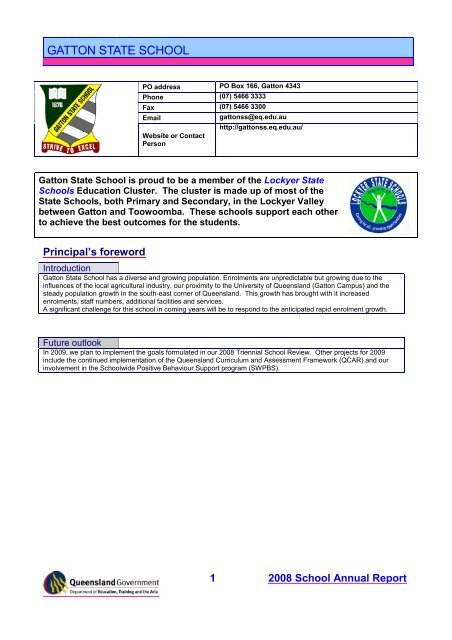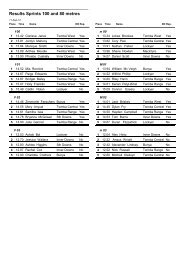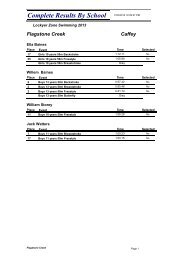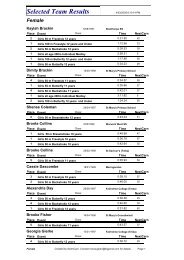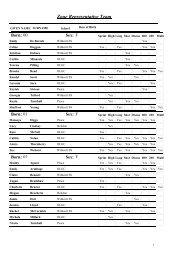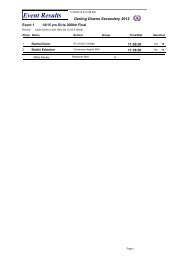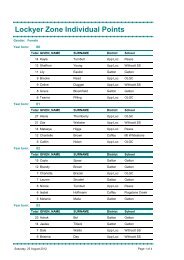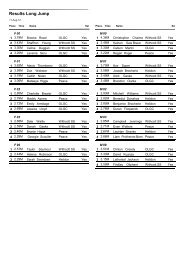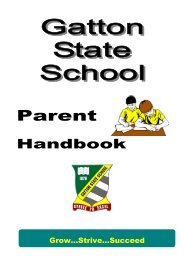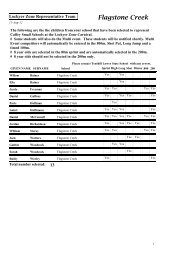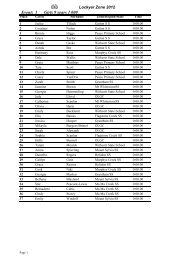Gatton State School - Education Queensland
Gatton State School - Education Queensland
Gatton State School - Education Queensland
Create successful ePaper yourself
Turn your PDF publications into a flip-book with our unique Google optimized e-Paper software.
GATTON STATE SCHOOL<br />
PO address<br />
Phone<br />
Fax<br />
Email<br />
Website or Contact<br />
Person<br />
PO Box 166, <strong>Gatton</strong> 4343<br />
(07) 5466 3333<br />
(07) 5466 3300<br />
gattonss@eq.edu.au<br />
http://gattonss.eq.edu.au/<br />
<strong>Gatton</strong> <strong>State</strong> <strong>School</strong> is proud to be a member of the Lockyer <strong>State</strong><br />
<strong>School</strong>s <strong>Education</strong> Cluster. The cluster is made up of most of the<br />
<strong>State</strong> <strong>School</strong>s, both Primary and Secondary, in the Lockyer Valley<br />
between <strong>Gatton</strong> and Toowoomba. These schools support each other<br />
to achieve the best outcomes for the students.<br />
Principal’s foreword<br />
Introduction<br />
<strong>Gatton</strong> <strong>State</strong> <strong>School</strong> has a diverse and growing population. Enrolments are unpredictable but growing due to the<br />
influences of the local agricultural industry, our proximity to the University of <strong>Queensland</strong> (<strong>Gatton</strong> Campus) and the<br />
steady population growth in the south-east corner of <strong>Queensland</strong>. This growth has brought with it increased<br />
enrolments, staff numbers, additional facilities and services.<br />
A significant challenge for this school in coming years will be to respond to the anticipated rapid enrolment growth.<br />
Future outlook<br />
In 2009, we plan to implement the goals formulated in our 2008 Triennial <strong>School</strong> Review. Other projects for 2009<br />
include the continued implementation of the <strong>Queensland</strong> Curriculum and Assessment Framework (QCAR) and our<br />
involvement in the <strong>School</strong>wide Positive Behaviour Support program (SWPBS).<br />
1 2008 <strong>School</strong> Annual Report
Our school at a glance<br />
<strong>School</strong> Profile<br />
The school caters for male and female students from Prep to year 7. In addition the school has a large Special <strong>Education</strong><br />
Program and an Early Childhood Development Class (ECDC) for children with disabilities who have not yet reached primary<br />
school age. The August 2008 enrolment for the school was 652.<br />
The school draws its enrolment from the town of <strong>Gatton</strong> plus other Lockyer Valley towns or rural residences. Between 35<br />
and 40% of the enrolment live outside of <strong>Gatton</strong>. These students travel to and from school by buses and private vehicles.<br />
Approximately 2% of students live at the University of <strong>Queensland</strong>, <strong>Gatton</strong> Campus and commute to school by bus or car.<br />
Due to the school’s proximity to the University of <strong>Queensland</strong> - <strong>Gatton</strong> Campus, plus our location in the Lockyer Valley, the<br />
school caters for the needs of many families from Non-English Speaking Backgrounds (NESB). These students make up<br />
5% of the school’s enrolment. In order to support these students, the school has an ESL <strong>Education</strong> Advisor who visits from<br />
Toowoomba for one to two days per week, depending on the number of NESB students enrolled at any one time. In<br />
addition, the school also employs teacher aides to work specifically with these students under the direction of the <strong>Education</strong><br />
Advisor.<br />
The school has an indigenous population of approximately 5%. In addition to classroom programs, indigenous students<br />
experiencing difficulty are provided with additional teacher aide support.<br />
The school experiences a large increase in enrolments each year between February and August. These increases are<br />
caused by the annual movement of itinerant workers, often from southern states. As a result, each year the school often<br />
experiences a change to class organization. On average, each classroom experiences 9 changes of enrolment each year.<br />
Over the last decade, school enrolments have increased steadily. With the construction of the <strong>Gatton</strong> prison commencing in<br />
late 2008, enrolments will continue to increase but probably at a faster rate.<br />
Special <strong>Education</strong> Program enrolments have also been steadily increasing.<br />
2 2008 <strong>School</strong> Annual Report
Curriculum offerings<br />
In term 4, 2008, the school offered upper school students a Middle <strong>School</strong> Options Program where each week one session<br />
was devoted to a variety of optional programs offered by teachers and aides.<br />
THE STUDENT COUNCIL is comprised of representatives from all classes in Years 4-7 as well as the school captains. The<br />
S.C. provides student perspectives into the operation of the school, funds special projects within the school and makes<br />
donations to charities.<br />
The <strong>School</strong>’s GIFTED AND TALENTED PROGRAM has been maintained in recent years . A variety of activities were<br />
conducted including:- the Annual Academic Awards Ceremony, Art & Craft, Robotics workshops, <strong>State</strong>-wide competitions,<br />
etc.<br />
ESL PROGRAM – ESL students make up 5% of the school’s enrolment. In order to support these students, the school has<br />
an ESL <strong>Education</strong> Advisor who visits from Toowoomba each week. The school also employs teacher aides to work<br />
specifically with these students under the direction of the <strong>Education</strong> Advisor.<br />
The school offers a distinctive HRE Puberty program for students in years 5-7. This program has operated for many years<br />
and has been extremely successful.<br />
The school offers distinctive MUSIC AND PHYSICAL EDUCATION PROGRAMS. The music program includes school<br />
choirs, a ‘Signing Choir’, recorder lessons for all year 4-7 students, a detailed classroom music program and an<br />
instrumental music program. The Physical <strong>Education</strong> program includes a wonderful swimming program, camps for<br />
year 5-7 students, interschool sport, etc.<br />
Extra curricula activities<br />
The school offers numerous extra-curricula activities to support the learning needs of our students. There are too<br />
many to list them all but some examples are included below:-<br />
Breakfast Program – several mornings per week<br />
Student Council<br />
Student leadership positions – school captains, house sporting captains, Music captains, Library monitors<br />
An organised lunch-time sports program<br />
Adopt-a-cop program<br />
Gifted & Talented Program<br />
Bicycle Safety Program<br />
How computers are used to assist learning<br />
Computers are an integral part of most subject areas at the school. Students from years prep to year 7 have access to<br />
both classroom computers and two computer labs.<br />
In 2008, the school took on the <strong>Education</strong> <strong>Queensland</strong> MOE (Managed Operating Environment) where all computers<br />
were linked to the network using a common state-wide system. To accomplish this goal, funds were spent to upgrade<br />
optical fibre and copper network connections plus repla ce some of the school’s aging computers.<br />
Social climate<br />
Surveys of parents, staff and students in 2008 indicate that <strong>Gatton</strong> SS is achieving above average results in this<br />
area:-<br />
In the annual <strong>School</strong> Survey, Parents gave the school a rating of 2.91 for <strong>School</strong> Climate as compared to 2.86 for the<br />
state mean. Students rated the school at 2.83 compared to the state mean of 2.84 while staff rated the school at 3.28<br />
for Morale as against 2.99 for the state mean.<br />
The school uses a variety of mechanisms to provide a supportive school environment. These include:-<br />
The school’s Responsible Behaviour Plan, the document which details how the school manages student behaviour.<br />
Key elements of the program include Behaviour Levels, anti-bullying procedures and regular reviews of student<br />
behaviour.<br />
<strong>School</strong> Chaplain – the school chaplaincy program operates for 5 days per week.<br />
Breakfast Program<br />
Student Council<br />
Lunchtime Craft Activities<br />
Student leadership positions – school captains, house sporting captains, Music captains, Library monitors<br />
An organised lunch-time sports program<br />
Outside <strong>School</strong> Hours Care & Vacation Care<br />
Adopt-a-cop program<br />
Gifted & Talented Program<br />
Bicycle Safety Program<br />
Reading Recovery<br />
Maths Support teacher paid from school based funds<br />
Teacher aide support for indigenous children<br />
3 2008 <strong>School</strong> Annual Report
Involving parents in their child’s education.<br />
Parent <strong>School</strong> Opinion Results for our school are consistently above the state average. We believe that this is due to the<br />
high degree of involvement offered to parents.<br />
The school community supports the Parents and Citizen Association and the running of the school tuckshop.<br />
The following committee also operates in the school but is not part of the P&C Association:-<br />
‘<strong>Gatton</strong> Concerned Parents for the Disabled’ – this is an incorporated parent group who manage commonwealth programs<br />
which support the Special <strong>Education</strong> Program and school.<br />
The school regularly liaises with the following community groups/personnel:-<br />
‘<strong>Gatton</strong> & District Ministers’ Fraternal’ regarding the school’s ecumenical Religious <strong>Education</strong> and the establishment of a<br />
school chaplain position.<br />
<strong>Gatton</strong> Police – usually with reference to the adopt-a-cop program<br />
<strong>Gatton</strong> Ambulance – conducting programs for students<br />
<strong>Gatton</strong> Hospital Social worker – regarding support for families in need<br />
Toowoomba Child and Mental Health – for student referrals<br />
Lockyer Valley Regional Council – in 2008 the school again won some Regional Green & Healthy <strong>School</strong> awards. This<br />
was supported by the close relationship which we have with the Shire Council.<br />
Local schools including the Lockyer District High <strong>School</strong><br />
Department of Child Safety<br />
Use of the school by the community is encouraged and is exampled by:-<br />
Community use of the schools sporting facilities on a regular weekly basis – tennis courts & sporting ovals;<br />
Regular use of the Admin Block by the <strong>Gatton</strong> Quilters for meetings<br />
Use of the school’s computer equipment & infrastructure by community groups<br />
Use of various buildings for inservice courses e.g. First-aid and brain Gym.<br />
Use of the school grounds by <strong>Gatton</strong> Outside <strong>School</strong> Hours Care;<br />
Use of the school tennis fence for free advertising of community events;<br />
Use of shade tents hired out for community events;<br />
VOLUNTEERS – One of the school committees manages the Volunteer program. Volunteers across the campus are<br />
provided with badges and sign-on books in various locations.<br />
Volunteers are acknowledged throughout the year and at a special function in term 4 where staff provided morning tea to<br />
volunteers to show their appreciation.<br />
All volunteers (over 100 each year) are provided with certificates of appreciation. This program will be continued in 2009.<br />
4 2008 <strong>School</strong> Annual Report
Our staff profile<br />
Qualifications of all teachers<br />
Highest level of<br />
attainment<br />
Number of<br />
classroom<br />
teachers and<br />
school leaders at<br />
the school<br />
Doctorate 0<br />
Masters 4<br />
Bachelor degree 29<br />
Diploma 15<br />
Certificate 2<br />
30%<br />
Doctorate Masters<br />
Bachelor degree Diploma<br />
Certificate<br />
4% 0%8%<br />
58%<br />
Expenditure on and teacher participation in professional development.<br />
The total funds expended on teacher professional development in 2008 was $26,866.<br />
The major professional development initiatives are as follows:<br />
<strong>School</strong> Wide Positive Behaviour Support (Behaviour) Training<br />
Year P-3 Literacy Training<br />
Laptop for Teachers Professional Development<br />
One<strong>School</strong> Training Program<br />
QCAR Planning<br />
QCAT Training<br />
Year 2 Net Moderation and Training<br />
Code of Conduct & Child Protection Training<br />
The involvement of the teaching staff in professional development activities during 2008 was 91%.<br />
Average staff attendance<br />
For permanent and temporary staff and school leaders the staff attendance rate was 95% in 2008.<br />
Proportion of staff retained from the previous school year.<br />
From the end of the 2007 school year, 94 % of staff were retained by the school for the entire 2008 school year.<br />
Student attendance<br />
The average attendance rate as a percentage in 2008 was 92 %.<br />
5 2008 <strong>School</strong> Annual Report
Performance of our students<br />
Key outcomes<br />
National Assessment Program – Literacy and Numeracy (NAPLAN) results - our<br />
reading, writing, spelling, grammar and punctuation, and numeracy results for the Years<br />
3, 5 and 7.<br />
Domain Measures Yr 3 Yr 5 Yr 7<br />
Average score for the school 365 449 524<br />
Reading<br />
Writing<br />
Spelling<br />
Grammar<br />
and<br />
Punctuation<br />
Numeracy<br />
Average score for <strong>Queensland</strong> 371.1 466.1 528.1<br />
For the school the percentage of students at<br />
or above the national minimum standard.<br />
2008 82 % 80 % 88 %<br />
Average score for the school 373 446 485<br />
Average score for <strong>Queensland</strong> 391.8 468.9 522.7<br />
For the school the percentage of students at<br />
or above the national minimum standard.<br />
2008 88 % 79 % 83 %<br />
Average score for the school 358 452 515<br />
Average score for <strong>Queensland</strong> 366.7 462.0 528.0<br />
For the school the percentage of students at<br />
or above the national minimum standard.<br />
2008 79 % 79 % 87 %<br />
Average score for the school 340 460 511<br />
Average score for <strong>Queensland</strong> 370.4 476.6 518.0<br />
For the school the percentage of students at<br />
or above the national minimum standard.<br />
2008 78 % 78 % 83 %<br />
Average score for the school 324 447 538<br />
Average score for <strong>Queensland</strong> 367.9 458.2 539.0<br />
For the school the percentage of students at<br />
or above the national minimum standard.<br />
2008 78 % 84 % 90 %<br />
Results in the Year 2 Diagnostic Net<br />
Percentage of students not requiring additional support<br />
Reading 60.6 %<br />
Writing 49.3 %<br />
Number 50.7 %<br />
Value added<br />
Year 2 children who are identified as requiring additional support in the year 2 net are provided with an intensive<br />
intervention program in term 3 each year. This program is co-ordinated by the key teacher and implemented by<br />
trained teacher aides.<br />
The school’s results in all areas are below the <strong>State</strong> average despite intensive intervention by school staff and support<br />
personnel. In recent years there has been a rapid increase in enrolments and the school has a large itinerant<br />
population. On average, each class experiences 9 children arriving or leaving during the school year. Many of the<br />
children who are identified as requiring additional support did in fact not start school at <strong>Gatton</strong> <strong>State</strong> <strong>School</strong> - these<br />
children have transferred in from other schools and states. Regardless of this, our programs do cater for these<br />
children and following intervention by the school in term three 2008 with those students identified for support, there<br />
was a marked improvement in results. Programs which we have been implemented in recent years such as supporta-talker<br />
and ELF (a metalinguistics program for prep children) will hopefully improve our results in future years.<br />
It was pleasing to see some areas where the children performed very close to the <strong>State</strong> means. These included the<br />
year 3 and 7 reading, year 3 spelling, year 7 grammar & punctuation and year 7 numeracy.<br />
Each year, Upper Primary Literacy Grant funding is available for students identified as having difficulties with the year<br />
5 test. These funds are used by the school to support the children in years 6 and 7 who require additional support.<br />
test. This program will continue in 2009 and we are hopeful it will assist in improving outcomes in future years.<br />
6 2008 <strong>School</strong> Annual Report
Parent, student and teacher satisfaction with the school<br />
There is a high level of satisfaction with the school by students, parents and staff as demonstrated by the following<br />
figures from the 2008 <strong>School</strong> Survey:-<br />
Parents: The overall parent satisfaction score for the school was 2.94 compared with 2.90 for the <strong>State</strong> mean.<br />
Staff: The overall staff satisfaction score for the school was 3.02 which was significantly above the <strong>State</strong> mean of<br />
2.85.<br />
Students: The overall student satisfaction score for the school was 2.90 compared with 2.98 for the <strong>State</strong> mean.<br />
Parent and student results were extremely pleasing. The student results were an improvement on those of 2008.<br />
7 2008 <strong>School</strong> Annual Report


